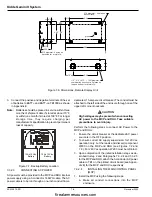
3-1
November 2002
06-235975-001
Kidde Gemini II System
CHAPTER 3
FUNCTIONAL DESCRIPTION
3-1
SYSTEM OPERATION
The previous chapter described the messages at the panel
and the operation of the indicators, switches, the buzzer
and other devices when an alarm, supervisory or trouble
message is generated.
This chapter focuses on alarms and logic for agent release.
It describes the conditions that initiate an agent release
and the outputs that are activated.
3-2
AGENT RELEASING LOGIC
The Main Control Panel and each Remote Hazard Unit con-
tain a complete, single hazard block, as shown in Figure
1-3. Though the Main Control Panel collects event infor-
mation from throughout the network and may direct the dis-
plays on global Remote Hazard Units, each unit has
separate input and output signals and its own program-
ming to determine if agent is to be released or if a sprinkler
system is to be activated.
Similarly, each unit has its own manual release and local
abort signal inputs. Manual release and abort signals af-
fect hazards only for that unit.
Agent release can be automatic or manual as explained in
the following paragraphs.
3-2.1
Manual Release
The manual release circuit accepts input from a manual
release switch such as a manual pull station. Activating this
switch closes the Alarm relay and starts the manual re-
lease sequence.
The manual release sequence includes activation of indi-
cating circuits 1 and/or 2 (as programmed) and activation
of the agent release output. A programmable relay, as well
as relays on the optional relay board, can also be activated
if configured to do so.
While for the MCP and RHU, the Manual Release Circuit is
always enabled, it must be enabled in the site-specific con-
figuration for the RDU. The release of agent subsequent to
activation of the manual release can be delayed from 0 to
30 seconds. It will be the same time delay as is configured
for the automatic release subject to a maximum of 30 sec-
onds. In other words, if the automatic release is delayed
for a time in excess of 30 seconds, the manual release
delay will be truncated at 30 seconds. The manual release
always overrides any active Abort input from that hazard.
3-2.2
Automatic Release
Auto release begins when a decisive alarm is detected at
the unit. When the unit is configured for single zone, a de-
cisive alarm occurs when the unit detects an alarm from
either Zone 1, Zone 2 or the Waterflow Circuit. If the unit is
configured for cross zone, two alarms must be active: ei-
ther (a) Zone 1 AND Zone 2 or (b) Waterflow AND either
Zone 1 OR 2.
Once the above condition is detected, the auto release
countdown begins. The countdown is defined by the auto
release delay and can be set from zero to 60 seconds.
Unless an abort signal is detected before the countdown
goes to zero, the following outputs are generated:
•
Indicating circuits 1 and 2 activate external audible and
indicating devices as programmed.
•
The Agent Release Circuit activates solenoids to oper-
ate the Suppression System.
•
The programmable relay and relays on the optional re-
lay board are activated if configured to do so.
Only automatic agent release can be aborted from an ex-
ternal abort switch as described in Paragraph 3-3.
Note:
For suppression systems with automatic release
of agent, the utilization of the cross-zone function,
with the Detection Circuits (Zone 1 and Zone 2)
comprising detectors that sense different smoke
or fire signatures, should be considered.
3-2.3
Operation of Clustered Agent Cylinder
Systems
In some installations, a single cluster of Agent Cylinders
may be required to provide the protection for several differ-
ent physical hazards. Such systems require the operation
of not only the Cylinder Solenoids to release the Agent, but
also of additional Stop Valve Solenoids to control its routing
into the appropriate hazard.
3-2.3.1
CLUSTERED SYSTEMS WITH IDENTICAL
HAZARDS
For clustered cylinder installations where each hazard in
the cluster is identical, as shown in Figure 3-1, the MCP is
designated as the Master and the associated RHUs are
designated as Slaves. While the RHUs control the opera-
tion of their respective Stop Valve Solenoids, the MCP con-
trols the activation of the clustered Cylinder Solenoids as
well as the Stop Valve Solenoid for the hazard that it con-
trols.
firealarmresources.com








































